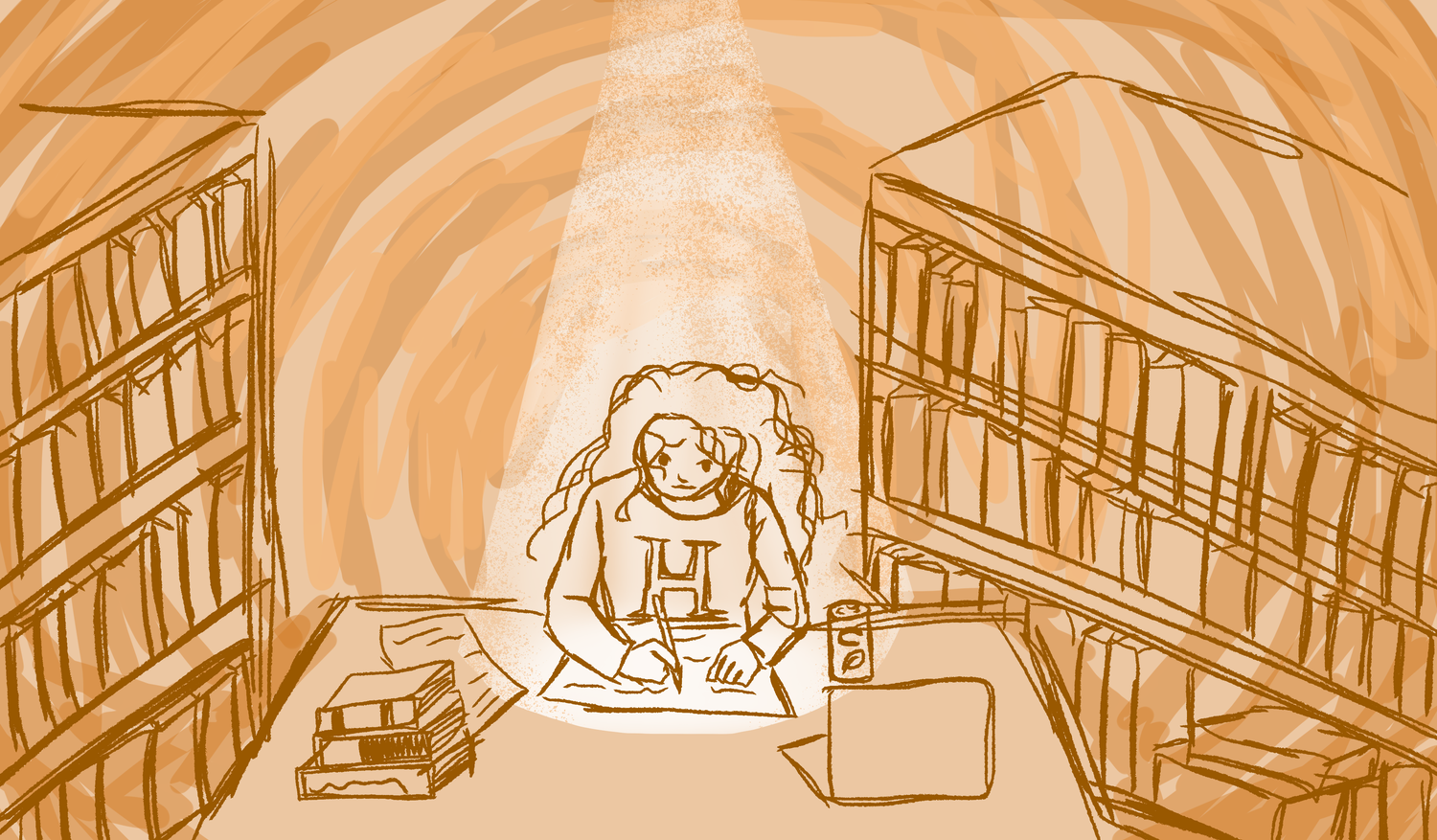Lamonster Aesthetics
In the early mornings, my roommate sneaks into our Wigglesworth suite in uniform: the previous day’s outfit drenched in exhaustion. She carries the residue of stress, psets, and honey-colored wood as she tumbles into bed to recharge after another late night shift in Lamont Library. She has, by some unfortunate fate, become a Lamonster.
My dear roommate, Analy Vega ’29, knows her way around Lamont most comfortably during the deep darkness of night. The hours in which she frequents the library are ones few dare venture into. “I feel very much like I’m in the trenches,” Vega tells me while I sit with her in the Lamont basement, well past midnight and surrounded by stale and dusty DVDs. She spends, on average, three out of five weeknights in Lamont, and I usually don’t hear her plunge into bed until 2 a.m. While speaking to me about these nights, which she has become notorious for in our suite, she admits that this isn’t what she envisioned for her life at Harvard.
Surrounded by peers that boast about their caffeine-fueled late nights in Lamont, Vega tends to keep her routine to herself. She, like many others, has seen individuals who aren’t so quiet about the Lamonster lifestyle. “I feel like, especially first week of classes, all the freshmen would post like, ‘Oh, yeah, like 3 a.m. in Lamont,’” she says.
Lamont Library is open 24 hours a day from Sunday through Thursday, allowing students to spend unfathomably late hours in the library. Amongst the student body, those who take advantage of this opportunity are affectionately known as “Lamonsters.”
But if the need for late-night studying were the only draw of Lamont, students would also flock to Cabot, another overnight library on campus. But while Cabot runs on the same schedule, its technocratic environment doesn’t have the same allure. Students are looking not only for a study spot, but for an aesthetic. Lamont is defined by its shelves of old books, soft low hanging lights, light wooden furniture, and warm-toned comfy chairs. It’s a space that you’d catch Rory Gilmore, the glorified high- achieving protagonist of the TV show “Gilmore Girls,” studying in. While browsing Pinterest, you’ll find snapshots of her in a wool sweater, locked into her books in cozy spaces. These high-achiever aesthetic Pinterest boards are also saturated with that image of Serena van der Woodsen from “Gossip Girl” surrounded by papers and notebooks in bed, sipping a cup of coffee.
Beyond the aesthetic of the library itself, the very concept of a “Lamonster” suggests a culture of studiousness that can become obsessive.
To investigate, I venture through Lamont as the clock inches towards 1 a.m. In the Lamont basement, I stumble upon Amy N. Cardozo ’29, diligently working over a table covered in loose papers. I ask Cardozo, a self-described Lamonster, what she thinks of this title. For her, it comes with negative connotations that can even border on concerning. “You stay here for late hours, but you’re just essentially overworking yourself,” she says.
It seems to me that Lamonsters are creatures of habit. You must intensely overwork yourself throughout high school to get into this institution, so after four years of sprinting, how do you suddenly slow down? While Lamonsters may not have envisioned a life of all-nighters when they rolled through Johnston Gate for the first time, it’s hard to crack down on the notions of what we think we should be doing; many of us came into Harvard with the idea that to be a Harvard student is to pull all-nighters, lack sleep, run on Dunkin’, and always be locked in — even during bedtime hours.
When we’re all surrounded by people who don’t sleep enough to supposedly get ahead of the curve, the social pressure tells us that we must conform for our own success. At Harvard, many students believe that to overwork themselves is to be one of the best. Due to this perception, students will take on an absurd amount of extracurricurriculars, classes, and commitments, resulting in these sleepless nights at Lamont.
But it’s not just the commitments themselves that keep people up at night, it’s their own inability to balance them — something my roommate readily admits. “It shows how bad I am at time management,” Vega tells me. She has heard Lamonsters complain about being overworked, but has seen the truth: “girl, you’re doomscrolling on Instagram reels,” she says. As I’m strolling through Lamont, I witness the same — chatting, a handful of doomscrollers, and one online shopper.
During this investigative shift, I find Zaid M. Al-Ississ ’28 working diligently in an oak wood cubicle on the first floor. Upon questioning, Al-Ississ confesses, “I am closested about my Lamonsterness.” Yet, he’s observed that many others are proud of the title. He mentions his suitemate who “goes around and flexes that she’s always in the cafe.” For students like Al-Ississ’s suitemate, being a Lamonster is not just about keeping up with classes, it’s about the image. We must display how overworked we are by mentioning our late nights during our 9 a.m lectures, grabbing to-go boxes from the dining hall, and posting Instagram stories of blurry psets sprawled across wooden cubicles. With our tragic sleep schedules as bragging rights, we seek out the praise disguised as condolences from our peers.
Studying at Harvard comes with a sense of responsibility. The Lamonster way of honoring such a gift is sacrificing their health. But this display of gratitude shouldn’t be the norm. Most Lamonsters do not need to be clocking in for a night in the trenches every weeknight. This culture traps us in toxic performativity that only serves to exhaust us, create perpetual burnout, and continue this destructive cycle.
Before leaving Vega to tough out a pset, I ask her the latest she’s ever been in Lamont. She shivers at the memory.
“Four. And it was empty. It was scary. I thought I was gonna get jumped by a rat.”



